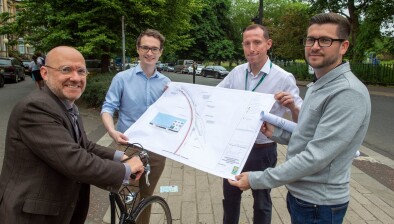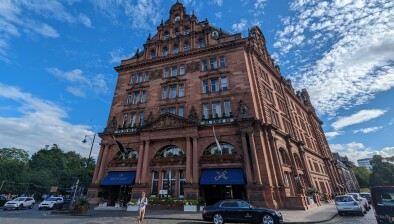Five projects progress to final stage of active travel competition

Designs for segregated cycle path schemes in Edinburgh, Glasgow, Stirling and Inverness have made it to the final stage of a competition for millions of pounds of funding.
Run by Sustrans Scotland and funded by the Scottish Government, the Community Links PLUS competition delivers pioneering and game-changing projects which inspire public bodies in Scotland to design better places and spaces for people to live, walk and cycle in for everyday journeys.
Each of the five finalists will now receive additional funding of up to £40,000 to complete detailed proposals and present to a cross-sector expert panel, chaired by Transport Scotland chief executive, Roy Brannen.
The winning design will be announced in late summer 2017.
Community Links PLUS aims to demonstrate that designing places around the needs of people delivers a wide range of benefits, including boosting local economies, smaller retailers, healthier communities and safer, more attractive streets.
The five finalist projects are:
Glasgow City Council (Woodside Mini-Holland) - comprising a strategic segregated cycle route along St George’s Road linking the Forth and Clyde Canal, regeneration work at Port Dundas and the Sighthill regeneration site with the City Centre and particularly the Sauchiehall Street Avenue project.
The plan features the creation of a ‘Dutch style’ people focussed area using a combination of infrastructure, including segregated cycleways with further improvements to support pedestrianisation and economic regeneration, to increase the attractiveness of the area for all who live and work there.
 The City of Edinburgh Council (The West Edinburgh Active Travel Network) – an attractive, direct and convenient cycling and walking route from the west edge of Edinburgh city centre at Roseburn to major business districts. A ‘mini Holland’ approach will be applied, evolving a car-dominated development into a people-friendly environment.
The City of Edinburgh Council (The West Edinburgh Active Travel Network) – an attractive, direct and convenient cycling and walking route from the west edge of Edinburgh city centre at Roseburn to major business districts. A ‘mini Holland’ approach will be applied, evolving a car-dominated development into a people-friendly environment.
This project will transform one of Scotland’s most significant business areas (Edinburgh Park and the Gyle, comprising 1.8km2) into a high-quality European-style pedestrian and cycle friendly neighbourhood
The City of Edinburgh Council (Meadows to George Street - streets for people) – an ambition to transform Forrest Road - George IV Bridge – The Mound - and Hanover St to streets where walking, cycling and public space take top priority. The design features a combination of segregated cycleways and shared road space with key innovations such as a ‘Trondheim-style’ bike lift to assist with those struggling to cycle up The Mound.

The Highland Council (Inverness City Active Travel Network) – a plan to strengthen the existing Inverness City Active Travel Network with improvements to the east-west corridor including cycle-friendly routes in Millburn Rd; Academy Street and The Raigmore Interchange.
At the heart of Highland Council’s proposal is an active city fit for the future; creating a Dutch style infrastructure, to encourage walking and more cyclists, promoting health, reducing congestion, creating and enlivening streets and public spaces. The project forms a major part of Highland Council’s plans for a sustainable future and to attract and retain a young, economically active population.
Stirling Council (City Boulevard & Cowane Street) - the creation of an integrated, attractive and high-quality walking and cycling network in Stirling along Cowane Street which provides the direct corridor between Stirling City Centre and Stirling Bridge, with onward routes to the large communities of Raploch, Cornton, Causewayhead, Bridge of Allan and the University of Stirling.
Plans also include the creation of a pedestrian and cycle-friendly streetscape from King’s Park into and through Stirling City Centre along Dumbarton Road/Albert Place, Wellgreen and Upper Craigs.
Last year’s winning entry, Glasgow City Council’s ‘South City Way’, impressed the panel with its exemplary design and place making potential. On completion in 2018, the South City Way will run from Glasgow’s Southside in to the heart of the Merchant City.
Announced as the winner in August 2016, The ‘South City Way’ was awarded £3,250,000 of funding from the Scottish Government through Sustrans, with the investment match-funded by Glasgow City Council.
Humza Yousaf, minister for transport and the islands, said: “I would like to congratulate the five projects that have made it through to the final round of the Community Links PLUS design competition.
“I am pleased to see that local authorities have again put forward very ambitious projects which will help to create a step change in conditions for walking, cycling and place making that communities can all benefit from.
“These kinds of place making projects are part of our long-term vision for active travel and also our recently published Cycling Action Plan for Scotland, which reiterates our commitment to maintain current levels of funding for the remainder of this Parliament.”
Daisy Narayanan, deputy director for built environment at Sustrans Scotland, added: “We are absolutely delighted with the extremely high quality of entries to our Community Links PLUS design competition. These proposals are exemplary in their understanding of the need to improve our streets for the well-being of everyone.
“They bode well for the future of Scotland. The Scottish Government, and in particular, Humza Yousaf MSP, the Minister for Transport and Islands, has demonstrated real vision in supporting this competition.
“Critically, local authorities across Scotland have shown they are keen to enable access for pedestrians and cyclists of all abilities. The country is embracing the health and economic benefits of a modal shift in how we design our streets and roads.”














